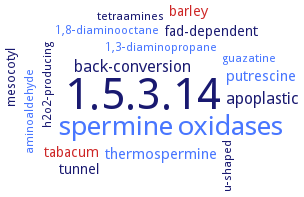1.5.3.14: polyamine oxidase (propane-1,3-diamine-forming)
This is an abbreviated version!
For detailed information about polyamine oxidase (propane-1,3-diamine-forming), go to the full flat file.

Word Map on EC 1.5.3.14 
-
1.5.3.14
-
spermine
-
oxidases
-
back-conversion
-
apoplastic
-
thermospermine
-
putrescine
-
tabacum
-
fad-dependent
-
tunnel
-
barley
-
mesocotyl
-
1,3-diaminopropane
-
tetraamines
-
aminoaldehyde
-
1,8-diaminooctane
-
h2o2-producing
-
u-shaped
-
guazatine
- 1.5.3.14
- spermine
- oxidases
-
back-conversion
- apoplastic
- thermospermine
- putrescine
- tabacum
-
fad-dependent
-
tunnel
- barley
- mesocotyl
- 1,3-diaminopropane
-
tetraamines
- aminoaldehyde
- 1,8-diaminooctane
-
h2o2-producing
-
u-shaped
- guazatine
Reaction
Synonyms
EC 1.5.3.11, flavin-containing polyamine oxidase, maize PAO, maize polyamine oxidase, MPAO, OsPAO7, PAO, ZmPAO
ECTree
Advanced search results
General Information
General Information on EC 1.5.3.14 - polyamine oxidase (propane-1,3-diamine-forming)
Please wait a moment until all data is loaded. This message will disappear when all data is loaded.
malfunction
-
the ZmPAO-K300M mutant is catalytically impaired with a 1400fold decrease in the rate of flavin reduction. Substrates are bound in an out-of-register mode and the HOH309 water molecule is absent in the enzyme-substrate complexes. K300 mutation brings about a 60 mV decrease in the FAD redox potential and a 30fold decrease in the FAD reoxidation rate, within a virtually unaltered geometry of the catalytic pocket
physiological function
additional information
-
active site structure of wild-type and mutant K300M enzymes, overview. The active site is formed by a catalytic tunnel in which the N5 atom of FAD lies in close proximity to the K300 side chain, the only active-site residue conserved in all PAOs. A water molecule, HOH309, is hydrogen-bound to the amino group of K300. The HOH309-K300 couple plays a major role in multiple steps of ZmPAO catalytic mechanism, such as correct substrate binding geometry as well as FAD reduction and reoxidation kinetics. Substrate binding mechanism and structure, and comparison to Saccharomyces cerevisiae Fms1, EC 1.5.3.17, overview. The differences include a planar conformation of the isoalloxazine ring in Fms1 versus a highly bent conformation in ZmPAO and important substitutions in the relevant topological positions of the active site, i.e. E170W, F171H, E62H, V196N, S87D, F318K, F403Y, V331F, T348L, Y169L and Y298L, numbering referring to ZmPAO. The substrate-binding site of Fms1 is more hydrophobic than that of ZmPAO
-
accumulation and further oxidation of free PAs in the leaf apoplast of tobacco plants occurs in a similar, although not identical way during tobacco defense against infection by microorganisms with contrasting pathogenesis strategies. This response affects the pathogens ability to colonize host tissues and results are detrimental for plant defense against necrotrophic pathogens that feed on necrotic tissue
physiological function
-
involvement of ZmPA-mediated H2O2 production in wound-healing events
physiological function
-
polyamine oxidase activity contributes to sustain maize leaf elongation under saline stress providing a significant production of reactive oxygen species in the apoplast
physiological function
-
role of MPAO in abscisic acid-induced antioxidant defense in leaves of maize plants
physiological function
-
plant PAOs oxidize the carbon at the endo-side of the N4-nitrogen of Spd and Spm, producing 4-aminobutanal and N-(3-aminopropyl)-4-aminobutanal, respectively, in addition to 1,3-diaminopropane and H2O2, and are considered to be involved in terminal catabolism of polyamines, physiological role(s) of the polyamine catabolic pathways in plants, overview
physiological function
a likely role for OsPAO7 during anther development is to deliver H2O2 for secondary wall thickening through lignin formation
physiological function
-
Nicotiana tabacum expressing PAO with reduced activity contained higher Ca2+ levels during salt stress, and show also reduced chlorophyll content index, leaf area and biomass, but taller phenotype compared to the wildtype plants during salt stress. Plants overexpressing PAO have more leaves with slightly greater size compared to the plants with reduced expression and higher antioxidant genes/enzyme activities. Accumulation of proline in the roots is evident at prolonged stress and correlates negatively with PAO deregulation as does the transcripts of genes mediating ethylene biosynthesis
physiological function
-
under drought stress, expression of polyamine oxidase genes PAO1, PAO2, PAO3, PAO4,PAO5, PAO6 and activity of enzymatic polyamine oxidation is increased in both relatively tolerant (Karoon) and sensitive (260) maize cultivars. The enhancement in PAO gene expression and enzyme activity is more prominent in Karoon cultivar compared to 260
physiological function
-
underexpression of PAO in Nicotiana tabacum correlates with increased thermotolerance of the photosynthetic machinery and improved biomass accumulation, accompanied by enhanced levels of the enzymatic and non-enzymatic antioxidants, whereas PAO overexpressors exhibit significant impairment of thermotolerance
physiological function
-
accumulation and further oxidation of free PAs in the leaf apoplast of tobacco plants occurs in a similar, although not identical way during tobacco defense against infection by microorganisms with contrasting pathogenesis strategies. This response affects the pathogens ability to colonize host tissues and results are detrimental for plant defense against necrotrophic pathogens that feed on necrotic tissue
-


 results (
results ( results (
results ( top
top






